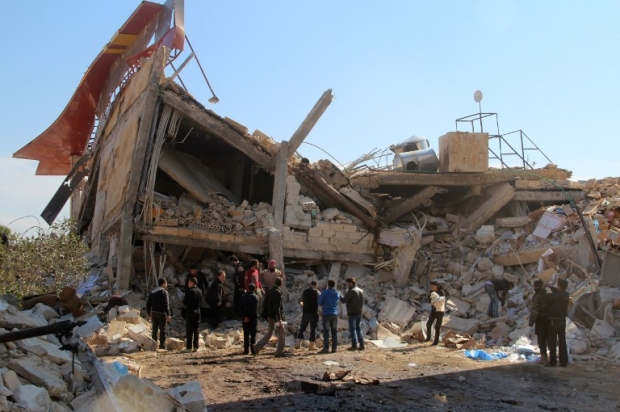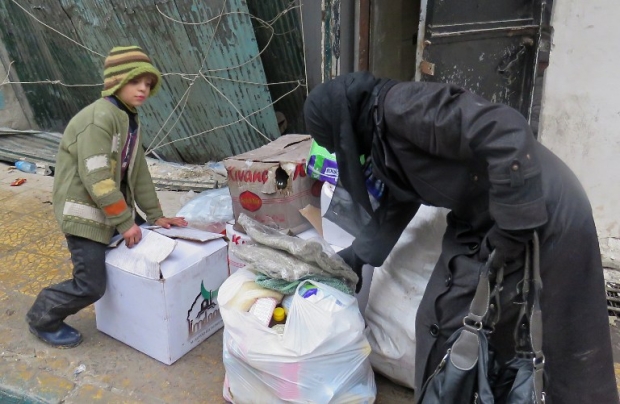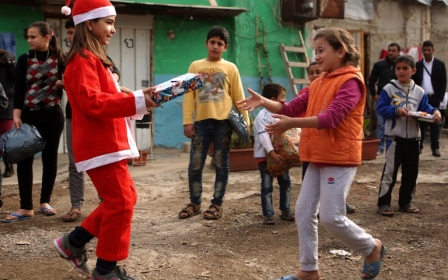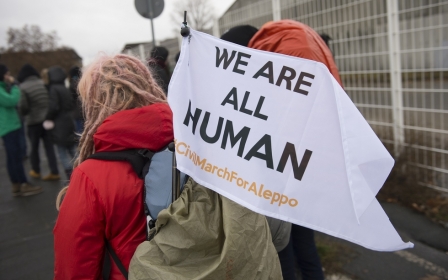
Surrender or die: Syria's sieges are the difference-makers in the conflict
On 13 December 2016, Bashar Jaafari, the current permanent representative of Syria to the United Nations, declared: “Aleppo has been liberated from terrorists and those who toyed with terrorism; Aleppo has returned to the nation.”
After more than four years of fighting in Syria’s economic capital, the Syrian army, alongside pro-regime militias and Russia, has recaptured the opposition-controlled eastern Aleppo.
Setting the skill of Hezbollah’s urban warfare and Russia’s juggernaut air force aside, it was the brutal siege of eastern Aleppo that laid the foundations for Assad’s major victory, which slowly began in February 2016, after the Syrian army and other pro-regime forces cut off Castello Road, the last supply route for opposition forces and civilians living there.
By November, Medecins Sans Frontieres (MSF, Doctors Without Borders) reported that there were 32 doctors for 250,000 besieged residents, with shortages of basic medicines, such as painkillers.
And the rest is history.
Aleppo was not the first city to be besieged, nor will it be the last. On 23 December 2016, 12-year-old Mohamed al-Maleh in Madaya, besieged by the Syrian army and Hezbollah since June 2015, was shot in the head by a sniper while playing on the roof, severely injuring him.
Al-Maleh is one of 1.3 million people trapped in besieged communities across Syria, primarily by the Syrian army and its allies. This does not include over 1.1 million others who are partially besieged or living in siege-like conditions, according to Siege Watch’s latest quarterly report on Syria.
Prior to the Syrian government and its allies reclaiming eastern Aleppo, it has used similar tactics to win back opposition-held areas in and around other major cities in Syria, including the capital Damascus, as well as Homs, Syria’s third-largest city.
This is an example of how the regime can benefit economically from sieges
Near the capital Damascus is the large opposition stronghold in eastern Ghouta. Though the siege of the area lasted for three years from 2013 and 2016, in a territory significantly larger than eastern Aleppo both in size and population, its complicated situation, both in terms of internal politics among the opposition factions, and the relationship between those besieged and government-held areas, kept it from taking centre stage in the media.
Aron Lund’s analysis on eastern Ghouta for The Century Foundation indicates that several distinct features of this siege made it even more effective for the Syrian government and its allies.
First of all, internal clashes between factions, including the notorious Salafi group Jaysh al-Islam, led to the fragmentation of opposition groups in the area. Moreover, the black market has been a major source of income for officials on the side of the Syrian regime, as smugglers and traders went in and out of the besieged territory from time to time.
Outside of war strategy, this is an example of how the regime can benefit economically from sieges, as well as rhetorically; the Syrian government and Assad have been referring to the opposition as extremist Islamists and terrorists ever since day one, and the president has portrayed himself and his allies time and again as protectors of secularism and of ethnic and religious minorities in Syria.
Despite being proven to be such an effective tactic, it is always civilians who pay the price for such sieges.
In Ghouta, over 200 civilians died due to lack of food or medical equipment between 21 October 2012 and 31 January 2015.
While the lack of essential aid alone has caused deaths, the besieged territory is not without airstrikes and shelling from the Syrian army and its allies.
The psychological impact of sieges drops the bar so low on what dignity looks like...the two options are starve or surrender
On the morning of 21 August 2013, rebel-held Ghouta was on the receiving end of rocket attacks containing sarin gas. MSF reported that they received around 3,600 patients “displaying neurotoxic symptoms in less than three hours” that very morning. More than 1,000 civilians died.
The siege of the Homs neighbourhood of Al-Waer came to an end with an agreement between the Syrian army and opposition forces on 1 September 2016, but not without years of suffering.
In August 2016, warplanes dropping a flammable substance killed people in their sleep, including two siblings both under the age of three. Though their mother survived, she suffers emotionally and psychologically.
One year prior to the Al-Waer agreement, during the truce negotiations, Al-Waer’s 75,000 residents, who have relied on growing their own food for some time, were astonished to receive “such a great quantity of aid”, which consisted of 14 trucks with food, blankets and clothes, and some basic medical supplies. The psychological impact of sieges drops the bar so low on what dignity looks like; after all, the two options are starve or surrender.
Extremist groups from Syria’s opposition have orchestrated sieges of their own. While they are significantly smaller in number and minimal at impact, they still exist, and they still cause the suffering of a civilian population.
Excluding sieges that involve both the regime and armed opposition groups, such as Yarmouk and Hajar al-Aswad, the towns of Fouaa and Kefraya in the Idlib governorate are besieged purely by extremist factions from the opposition.
While residents receive aid via airdrop every two weeks, the conditions are still appalling.
The truce that ended the siege of Al-Waer involved the systematic evacuation - which resembles evictions, if anything - of civilians and fighters, including the injured, in exchange for the Syrian army to regain control of the area.
'The basis of these truces is using injured and sick people, dying people, as bargaining chips'
- Hadeel al-Shalchi (HRW)
Human Rights Watch Syria researcher, Hadeel al-Shalchi, has described these truces as using civilians as bargaining chips. In a phone interview, she explains the unethical foundation of these truces, saying: “The basis of these truces is using injured and sick people, dying people, as bargaining chips.”
The most notable example of this is the Four Towns Agreement, which comprises Madaya and Zabadani, besieged by Assad and Hezbollah, as well Fouaa and Kefraya, besieged by Jaish al-Fateh.
The agreement, pushed for by the United Nations Office for the Coordination of Humanitarian Affairs (UNOCHA), was intended to provide unconditional aid and support. While it was agreed upon in September 2016, it fell apart two months later due to various incidents of violence in the respective areas.
Providing the passage of aid or the freedom of movement for people has become a tit-for-tat tactic. If one town has a person that needs medical help, but can’t leave, the same will happen for another.
It’s a vicious circle that is leading Assad and his allies to major victories at the expense of ordinary Syrians.
Accountability is the elephant in the room
The lack of any meticulous monitoring has prolonged the sieges, and enabled those doing the besieging to impede aid deliveries.
'UN agencies are not monitoring and reporting aid inspection by the Syrian government which is limiting what people receive and are not holding actors accountable for diverting aid'
- Reema Hibrawi (The Syria Institute)
Reema Hibrawi, programme manager and analyst of The Syria Institute, says this is a cause for great concern: "If UN humanitarian aid is sent, it is insufficient. Few UN aid convoys go through Syrian government checkpoints and approvals, and the supplies support a fraction of the besieged population.
"The majority of civilians do not have their basic needs met including food, medical or heating supplies. UN agencies are not monitoring and reporting aid inspection by the Syrian government which is limiting what people receive, and are not holding actors accountable for diverting aid."
Indeed, we often read about aid from the UN, the ICRC, and Syrian Arab Red Crescent, but we never know what happens after those trucks arrive.
Moreover, much of the aid that has come is not what the residents need. Residents in Darayya received a UN aid delivery, which included one bottle of lice shampoo for every two residents, and over a thousand sand-fly nets: items that are far from essential in a town devoid of basic foodstuffs and medicines.
The sieges are thus prolonged, with a PR success for the Assad government, given the general assumption that (1) the aid being brought in is what the starving population needs, and (2) the aid is distributed equitably and the aid isn’t confiscated or tampered with.
Going forward: a Syrian Nakba in the making?
As besieged areas are attacked until its starving residents surrender, a new problem emerges. While the Syrian government with the help of Russia and other allies takes back areas they have besieged, its residents are being evicted under the guise of an evacuation, to Idlib, which is the remaining hub of the Syrian opposition.
There has been no guarantee from the Syrian government that the displaced will return to their homes
While the Syrian government has stated that it has been welcoming fleeing besieged residents with open arms, the UN reported that hundreds of men have gone missing while crossing from previously opposition-held eastern Aleppo to government-held Aleppo.
Furthermore, the formerly besieged are now internally displaced: Idlib has been feeling the pressure of the influx of thousands of Syrians who need medical assistance among other support.
There has been no guarantee from the Syrian government that the displaced will return to their homes, nor that those who flee to government territory will not be persecuted.
Surely, such a situation can be described as a nakba - or catastrophe - equivalent to the one experienced by the Palestinians in 1948. And it doesn’t appear that this problem will be addressed anytime soon.
Hibrawi from The Syria Institute does not expect this problem to be resolved, stating, "It’s difficult to see things ending well. Forced population transfers displaced thousands of people into Idlib province. Attacks continue to increase in Idlib along with Eastern Ghouta in Damascus countryside, Al-Waer in Homs countryside, and Aleppo western countryside. Lack of accountability also continues for the sieges across Syria and the recent forced population transfers."
It would not be farfetched to say a siege of Idlib is in the works - an unnamed member of Hezbollah claims that the tactic will continue to be used, including in Idlib. So, let’s make it official: the deliberate starvation of people is a viable tactic in Syria, and there are no signs of it stopping anytime soon.
- Kareem Chehayeb is a Lebanese writer and musician based in Beirut. He is the co-founder of Beirut Syndrome, a grassroots media platform. You can follow him on Twitter @chehayebk
The views expressed in this article belong to the author and do not necessarily reflect the editorial policy of Middle East Eye.
Photo: A Syrian boy sits with belongings he collected from the rubble of his house in Aleppo, 17 December, 2016 (AFP)
New MEE newsletter: Jerusalem Dispatch
Sign up to get the latest insights and analysis on Israel-Palestine, alongside Turkey Unpacked and other MEE newsletters
Middle East Eye delivers independent and unrivalled coverage and analysis of the Middle East, North Africa and beyond. To learn more about republishing this content and the associated fees, please fill out this form. More about MEE can be found here.








